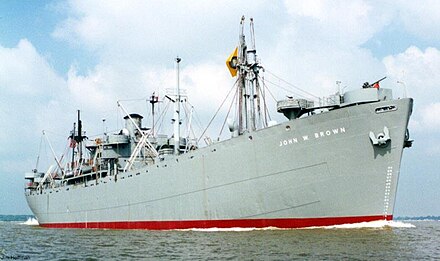Diving the Cape Peninsula and False Bay/SS Thomas T Tucker
Diving the Cape Peninsula and False Bay/SS Thomas T Tucker
The dive site SS Thomas T Tucker is a shoreline rocky reef with a recent wreck in the Southern Peninsula area on the Atlantic Seaboard of the Cape Peninsula, near Cape Town in the Western Cape province of South Africa.
Understand
See also: Diving the Cape Peninsula and False Bay#Understand
This ship was wrecked high on the rocks, and parts of the wreckage are visible on shore. Most of the wreckage is in fairly shallow water.
Position
This site is in the Table Mountain National Park Marine Protected Area since 2004. A permit is required.

Name
The "SS Thomas T. Tucker" (Hull Number 269) was a U.S. liberty ship produced by the Houston Shipbuilding Corporation which ran aground at Olifantsbospunt on November 27, 1942, during heavy fog while on her maiden voyage from New Orleans to Suez, carrying a cargo which included tanks and ammunition.
Class and type: Cargo ship Displacement: 14,245 long tons
Length: 135 m
Beam: 17.3 m
Draft: 8.5 m
Propulsion: Two oil-fired boilers, triple-expansion steam engine, single screw, 2,500 horsepower (1,864 kW) Speed: 11 to 11.5 knots
Range: 23,000 miles
Capacity: 10,856 metric tons deadweight (DWT) Complement: 41 men Armament: Stern-mounted 4-in deck gun for use against surfaced submarines, variety of anti-aircraft guns
Depth
The wreckage is in shallow water. Maximum depth is probably less than 10 m.
Visibility
Visibility is not often good, as the wreckage is in what is usually the surf zone, and only really divable when the sea is quite flat. However this means that even when the water is fairly dirty, there is still adequate light. Don't expect visibility of more than 5 or 6 metres, and it could be less.
Topography
Sandstone reef, fairly flat with narrow jointing crevices, no sand, but quite a bit of gravel in crevices, some gravel quite dark in colour. Wreckage extends beyond the high water mark, so is easy to find.
Geology: The reef is Ordovician sandstone of the Peninsula formation. Strike os probably east-west, Dip nearly flat, south.
Conditions
The site is very exposed to wind and sea from the north west to south west, so should be dived only in exceptionally flat seas. The site is protected from south easterly seas, though it will catch the wind, but if a westerly swell picks up you will have to leave before it gets too rough.
The site is most likely to be diveable in late spring and summer but there may be occasional opportunities at other times.
Get in
See also: Diving the Cape Peninsula and False Bay#Boat dives
The site is only accessible by boat, as there are no roads providing reasonable shore access. It is 11.2 km from the slipway at the old crayfish factory north of Scarborough, about 17.1 km from the launch site at Kommetjie and 27.5 km from Hout Bay harbour slipway.
See
Marine life
See also: Diving the Cape Peninsula and False Bay#The marine ecology
Big ecklonia forests, lots of small red and brown saweeds and heavy coralline encrustation on wreckage. Sheltered areas under wreckage have more variety <gallery mode=packed> Image:Coralline and other algae at the Thomas T Tucker DSC00770.JPG|Coralline and other algae on the reef Image:Sponge at the Thomas T Tucker DSC00774.JPG|Sponge at the wreck site Image:Reef life at the Thomas T Tucker DSC00771.JPG|Reef life at the Thomas T Tucker </gallery>
Features
Fragmentary wreckage of a steel steamer.
Photography
Don't take a big expensive camera to this site, particularly if it has external strobes, unless the sea is extremely flat. A small pocket camera will be easier to protect in the surge, and easier to hold still to frame a shot.
Suggested Routes
No particular routes recommended.
Stay safe
See also: Diving the Cape Peninsula and False Bay#Stay safe
Hazards
Strong surge.
Skills
No special skills required.
Equipment
See also: Diving the Cape Peninsula and False Bay#Equipment
No special equipment recommended
Nearby
Back to the Alphabetical list of sites, or list of dive sites in the Atlantic South Peninsula area
Other regional dive sites:
